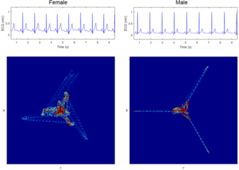 The paper “Beyond HRV: Analysis of ECG Signals using Attractor Reconstruction“ by Jane Lyle, Peter Charlton (KCL), Esther Bonet-Luz, Gary Chaffey, Mark Christie (KCL), Manasi Nandi (KCL) and Philip Aston has been published in the proceedings of the “Computing in Cardiology 2017 Conference“. The paper applies the attractor reconstruction method to ECG signals. Machine learning is applied to features extracted from the attractor, and to standard ECG intervals, for the task of identifying gender from the ECG signal. The attractor reconstruction method gives an accuracy of 96.3% compared to the standard intervals that give an accuracy of 77.7% on baseline data, and so our new approach performs significantly better. Interestingly, training a machine on baseline data and testing it on a wider dataset that includes data collected after treatment with drugs that have a significant effect on the ECG morphology only results in a slight drop in accuracy to 93.1% and 74.2% respectively. Identification of gender from ECG data was used as a test problem. However, the fact that gender can be determined with high accuracy suggests that gender should also be taken into account in detection of disease, diagnosis and treatment.
The paper “Beyond HRV: Analysis of ECG Signals using Attractor Reconstruction“ by Jane Lyle, Peter Charlton (KCL), Esther Bonet-Luz, Gary Chaffey, Mark Christie (KCL), Manasi Nandi (KCL) and Philip Aston has been published in the proceedings of the “Computing in Cardiology 2017 Conference“. The paper applies the attractor reconstruction method to ECG signals. Machine learning is applied to features extracted from the attractor, and to standard ECG intervals, for the task of identifying gender from the ECG signal. The attractor reconstruction method gives an accuracy of 96.3% compared to the standard intervals that give an accuracy of 77.7% on baseline data, and so our new approach performs significantly better. Interestingly, training a machine on baseline data and testing it on a wider dataset that includes data collected after treatment with drugs that have a significant effect on the ECG morphology only results in a slight drop in accuracy to 93.1% and 74.2% respectively. Identification of gender from ECG data was used as a test problem. However, the fact that gender can be determined with high accuracy suggests that gender should also be taken into account in detection of disease, diagnosis and treatment.
